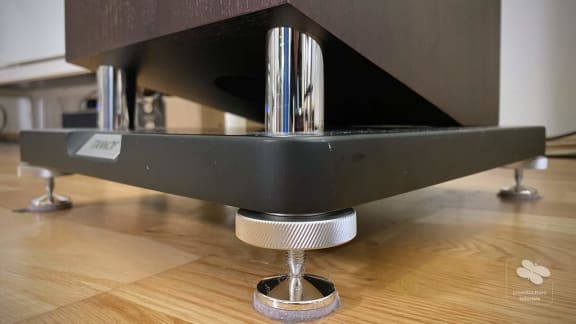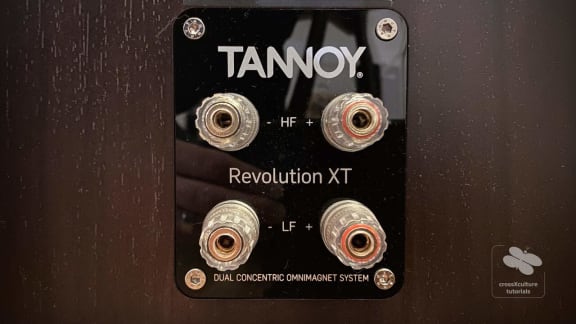Tannoy XT8f
Published: 20/10/2020
Manufacturing date: 2016
Author: Karsten Hein
Category: Gear & Review
Tag(s): Loudspeakers
My original intention was to sell off a pair of speakers and not so much to purchase a new one. But when a caller expressed interest in my pair of KEF iQ30 bookshelves, somehow I could not help but enquire more deeply about the reason for his interest. It turned out he had a small listening room, and that his current speakers were simply too large for the job. To my surprise, these were of the exact brand and model that I had been running a web search on for some time. We consequently agreed that he would bring his current speakers along when auditioning mine. What a strange coincidence that was.
To replace our KEF iQ30 bookshelves, I had originally purchased a slim pair of Tannoy DC6t floor-standing speakers. And, although these sounded fuller, I could not rid myself of the sensation that they, too, were lacking the muscle to fill our 70 sqm office with music. While being articulate and pleasant in their presentation, their performance mostly inhabited the space right up to the listening position (at about one-fourth of the room’s depth), rather than filling it completely. Granted, the pair of Tannoy DC6t was better suited than the KEFs for this location, but it still seemed a little light on the bass, not terribly underperforming, but not impressive either.
Replacing the DT6t with even larger speakers was not going to be easy. The trouble is, when your listening space is a sleek and modern office, this does set some limits to the possible speaker choices in terms of colours, shapes, and sizes. And since the DC6t had already been approved by the other household dwellers, I tentatively set up a web search on the next larger (and more recent) model, the Tannoy XT8f. Hence my excitement when I heard over the telephone that there now was a pair of XT8f on offer — and that this was even going to be brought to our house, instead of us having to take the trip.
As you might imagine, our double-interest in each other’s speakers created a strange scenario, in which either side had something to gain and something to lose. I could see that it would be a challenge for us not to let this get in the way of enjoyment. Upon his arrival, I helped our guest by carrying up one of his Tannoy XT8f speakers, and I immediately noticed how large and heavy they were in comparison to our present DC6t. Although they were only wrapped in thin blankets and not stuck in bulky boxes, I had to take especially good care not to scrape them along the inner walls or banister of our stairwell.
Since the original reason for his visit had been the KEF iQ30s, we decided that they should be auditioned first. I had them hooked up to our DB Systems DB1 + B&K ST140 system in our main listening room. We had a choice of vinyl, CD, as well as the possibility of streaming via Amazon Music available, but we ended up only playing CDs, some of which he had brought along as his reference. It is always fun to listen to other people’s music, and so I simply sat and listened to new sounds or enjoyed playing some of my own. The KEFs do play well in our main listening room, and there were moments in which I forgot the original purpose of our meeting and was simply taking in the music.
Without a final decision on whether he would purchase my KEFs, we proceeded to our office upstairs. Here, our Tannoy DC6Ts were still connected to the Restek V1 + Hafler XL280 combo. With everything perfectly set up from hours of listening, I asked him to sit down and listen to these first. I know how our system sounds, so I simply stood aside and let the music play. My impression was that he enjoyed what he was hearing, however, the second purpose for his coming to Frankfurt was for me to decide whether I was interested in the larger Tannoys that he had brought for me. We therefore quickly took the protective blankets off and connected the XT8Fs to our system.
My first impression was that the sound was muddled and massive, resonating far too chaotically in the large office space. Would I be able to make them blend in with the room, and what was it worth to me to find this out? After all, where the DC6T had been articulate and refined, the larger speakers now seemed disorganised and colossal. However, since this forum is called ‘Explorations in Audio’, you can probably guess my final decision, although it was not one that resulted from a positive first impression. That they already had some bumps and bruises on the finish only contributed to this sensation. What consoled me was the fact that the whole room was energised by these new speakers. And this was the one thing the smaller Tannoys had been missing. We both made our respective purchases, content with each other’s offers, and the buyer went on his way.
I have learned not to judge new gear arrivals too quickly. Some of the best devices I have ever owned, have taken me weeks, if not months to set up well. New speakers can be tricky in this way, because many factors come into play: distance to the front and side walls, width of placement and toe in angle, listening position, and system matching, to mention just a few. These factors are hardly solved within a day’s work, as even one centimetre difference will have a pronounced effect on the speaker’s ability to perform. While this is true for all speakers, larger speakers tend to be more difficult to place, especially when taking interior design considerations into account.
Given some time to experiment, I came up with a placement that allowed me to keep my accustomed listening position at about one-fourth of the room’s depth with only minor adjustments. The XT8F are positioned about 20cm further away from the front wall than the DC6T had been, and my listening position had to be moved 10cm back. This way, the toe-in could remain unchanged with both speakers directed just past my ears instead of straight at them. This has a positive effect on sound stage and reigns in the highs which are a bit overly pronounced when played on axis. During the placement I listened to Bruce Springsteen’s Song "Tougher than the Rest" from his live on-Broadway performance. This way I could be sure that there was a real stage to be recreated. In fact, I listened to it so many times in an endless loop, I have been humming it ever since.
The XT8f have a full and rich sound, in comparison with the DC6t, but also more generally speaking. At close distance, the sensation is one of bathing in music. There is plenty of good quality bass, and due to their 91dB performance at just one watt, they play loud with ease. Although they look chunky and provide plenty of tonal depth, they play voices intimately, as if listening to a cozy living room performance. This contrast of mighty roar and delicacy is highly addictive to my ears. Due to their concentric construction, the XT8f are very exact when it comes to locating instruments. Perhaps not quite as exact as the DC6t but still industry-leading at this price level. If the DC6t sounded as though one was taking part in a studio session, the XT8f invite you to the jazz club. Both speakers are insightful enough to be entertaining at all times, but if the room is right, the eights appear just a bit more rounded, especially towards the lower end. I now understand that in a smaller room this much bass can be overwhelming.
Also see: Tannoy XT8f Audio Demo
When the music is subtle, the XT8f will play this with delicacy and insightful detail, and when the orchestra swells, their excellent dynamics generated from a 50 litre corpus with down-firing bass port will thrust forward with a vengeance. I could not detect any compression when going loud, which is new to me and wonderfully pleasing. It quickly became clear that this is a completely different beast. Those who purchase the XT8f hoping for an upgrade to their DC6t might be disappointed that their room is simply too small of a playing companion. But those who have ended up with the DC6t in error, like myself, have a real chance of being very happy.
Specifications:
- Cabinet design: floor-standing, ported (down-fire)
- Drivers: 1x 1-inch titanium dome tweeter, 1x 8-inch paper cone midrange (dual-concentric), 1x 6″ paper cone woofer
- Frequency response: 34 Hz - 32 kHz, -6 dB
- Nominal impedance: 8 ohms
- Sensitivity: 91 dB
- Crossover frequencies: 250 Hz & 1.8 kHz
- Power handling: 100 watts RMS
- Dimensions: 1080 x 317 x 345mm
- Year 2016





